In 2021, Non-Fungible Tokens (NFTs) exploded, creating a $40 billion market seemingly out of thin air. Most of these were pieces of digital art, which, thanks to NFT technology, could be owned for the first time. But NFTs have also been used for practical applications, serving as event tickets as well as vaccine passports, and playing multiple roles in the gaming world.
What Is an NFT? What are Non-Fungible Tokens?
Given the popularity of both digital art NFTs and cosmetic collectibles (“skins”) in games, developers have been creating collectibles and skins as NFTs in a number of games. Some games also reward players with cryptocurrency for completing challenges within the game. These in-game rewards and NFTs can then be traded or sold for real money via NFT marketplaces and crypto exchanges.
NFTs as In-Game Collectibles
The Market for In-Game Collectibles
In-game collectibles have been around much longer than NFTs. Counter-Strike, a competitive first-person shooter, has allowed players to earn, trade, buy, and sell cosmetic skins since 2013. However, such transactions could only take place on Steam, the gaming marketplace run by the game’s creator, Valve. The most valuable of these sold for a whopping $150,000.
The video game Fortnite further proves just how profitable these in-game collectibles can be. In 2021, the game made over $50 million from a single set of NFL skins, which players could purchase to make their in-game character look like their favorite football player. Overall, the game has raked in over $10 billion dollars since its release in 2017. And a large chunk of that came from players purchasing cosmetic collectibles that have no effect on the gameplay itself and can’t be resold.
How NFTs Improve Upon this Established Business Model
Much of the new breed of gaming NFT collectibles typically work in a similar fashion, with one important caveat: NFTs provide ownership independent of any single market. Once you own an NFT, it’s yours. The company that created (“minted”) the NFT has no control over what you do with it.
In the unlikely event of the Steam marketplace shutting down, Counter-Strike skins would all evaporate. The skin someone paid $150k for would no longer exist. And while Fortnite skins typically cost $20 or less, the millions of skins players have purchased could all disappear if the game publisher decides to stop supporting them. But none of these risks would exist if the digital goods in these games were NFTs.

While it might seem like gaming companies stand to earn more by maintaining control of these collectibles, that’s not entirely true. When minting an NFT, its creator can include a “royalties” clause, so to speak. By doing so, the creator will collect a percentage of the proceeds every time that NFT changes hands. And royalties from sales on the secondary market could easily surpass the amount the creator originally earned by selling the NFT to its first patron.
New Features that Blockchain and NFTs Bring to Gaming
As profitable as skins may be to gaming companies, they don’t really change anything other than aesthetics. But NFT games open up a new world of possibilities. Let’s look at some of the ways these technologies are being put to use in one of the most popular crypto games.
Play-to-Earn Games
Blockchain games like Axie Infinity allow players to earn Smooth Love Potion (SLP), a token on the Ethereum network, by completing daily challenges and progressing through the game. Players can then sell SLP on a crypto marketplace for real-world money. The game itself is similar to Pokémon, tasking players to collect and “train” cute, little creatures (Axies) they can use to battle other players.
Playable NFTs
Each specific Axie is an NFT, allowing them to be bought, sold, and traded via the game’s marketplace. In fact, to play the game, you must purchase at least three Axies. Many of these digital creatures cost around $10, but the most expensive one sold for a whopping $820,000. There’s no charge for the game itself, just for the characters you need to play it.
Minting NFTs

Although Axies belong to one of nine classes, each creature has a unique set of “genetics.” As a result, you can “breed” two of your Axies to create a new one, with the parents’ genetics playing a large role in the genetics of the offspring. And since each Axie is an NFT, breeding Axies mints a new NFT that can be used in-game, traded, or sold.
As is always the case with NFTs, minting them costs money. So players must spend SLP, which they’ve earned in-game or purchased for real-world money, to breed their Axies. The cost to do so ranges from 1.8K to 30.6K SLP ($23 – $391 at the time of writing). The range corresponds to the number of times you’ve bred a particular Axie. Thus, it gets progressively more expensive to breed any specific Axie.
Crypto Gaming Scholarships
Not everyone has the time to play games to earn money. Not wanting to exclude anyone, Axie Infinity allows players to provide “scholarships.” In essence, players can lend out their creatures to anyone willing to put the time and effort into training and battling them. The owner and the scholarship recipient then split the rewards earned by the Axie.
When you realize that completing challenges and battling opponents might only earn you $1-2 worth of SLP after several hours of play, scholarships seem like a smart way to reap the benefits of in-game rewards without sucking up all of your time. Just know that you’ll likely need a stable of Axies to lend out if you plan on making more than some extra spending money.
NFT Land Rights (in Games)

The Axies’ virtual world includes thousands of plots of land that players can purchase to build upon and harvest for resources. As you might have guessed, these plots are all NFTs, enabling them to change hands if the players so desire.
Although this aspect of the game is still in development, it promises to provide players with the ability to earn rewards for use in-game and in the real world. In-game, these rewards will include items for crafting, character upgrades, and more. In the real world, rewards will include crypto (which can be sold for cash) and merchandise from the game.
NFT Card Games
Although they aren’t used in Axie Infinity, card games are one of the most obvious use cases for NFTs in games. Collectible card games, like Magic the Gathering and Pokémon, have been around for decades. Each card performs a function in the game, but it also has a value in the real world that correlates with its rarity and desirability.
Digital versions of these card games already exist, but without a way to sell or trade the cards that you purchase or earn within the game. By introducing NFTs to these games, players would own the cards they have in the game, just like the physical versions of the game. Players could sell their cards or trade them to other players, and the creators could collect a cut of every such transaction.
NFTs in Gaming: Passing Trend or Beginning of an Era?

It’s too early to tell whether NFTs will become a mainstay of the gaming industry. But at this point, it seems clear that there will at least be a niche market in which crypto gaming will continue to grow.
New mechanics, like the option to breed/mint creatures/NFTs in Axie Infinity, hint at the possibilities of this new technology in the gaming space. But for crypto enthusiasts who can’t see the appeal of earning crypto in games, don’t worry, you can still buy bitcoin online with a credit card.








